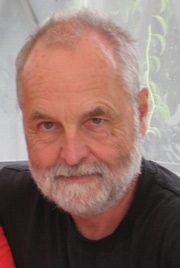Invasive species and the steward's role
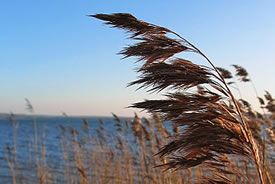
Phragmites (Photo by Wikimedia Commons)
More and more land is being conserved these days by various conservation groups. This is a good thing, but coming with that is a responsibility to protect and manage that land. Unless there are local offices, the most efficient way to carry out this responsibility is through a stewardship system.
One model is to have local volunteers, or land stewards (such as myself), who live near the property keep an eye on things. Some organizations formalize this by asking their stewards to submit one or two reports per year. The reports provide a checklist that points stewards to report on particular elements.
One important element of my job as a volunteer land steward is to check on invasives, and report on non-native plants that should not be there. This might require some education. Periwinkle, for example might be seen as “pretty,” as opposed to being a scourge on the landscape.
There are four steps I use when dealing with invasives:
- document location and numbers;
- make plans for their removal;
- carry out the plan; and, most importantly
- follow up.
Document location and numbers
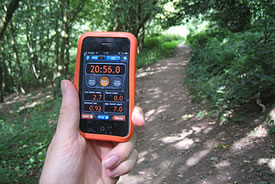
GPS device (Photo by Wikimedia Commons, Harry Wood)
Rarely is an invasive species eliminated in one operation. Like dandelions in a lawn, one should expect that their permanent removal is never going to happen. Too often there is a huge effort made at a removal, followed by discouragement that it came back worse than ever.
Documenting location and numbers is best done using GPS and having that data fed into a central database. Pictures can be incorporated as well and will provide a valuable reference. One should also do this documentation when the plant is most visible, for example in flower or at times when the leaves stay on a non-native plant later than the surrounding native plants.
Make plans for removal
The next step is making a plan for removal. Many non-native species do not spread aggressively and their removal can be given a very low priority. The first step then would be to prioritize. The priority process would have to take into account the physical location where the invasive is growing and an assessment of its potential to spread.
One area to be prioritized can be around or along trails. There is a great potential for hikers and animals to spread seeds along hiking trails (inadvertently of course), so removing the seeds of invasive species from these areas can be high priority. This also means that visitors to our properties can enjoy seeing lots of native plants instead!
Carry out the plan
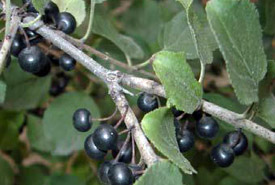
European buckthorn berries (Photo by Helen Fabbri, City of Winnipeg Naturalist Services Branch)
The removal technique will depend on the plant. Garlic mustard, a biennial (meaning it starts from a seed) lives for two years (flowering in the second) and then dies. It makes sense then that we must not let the flower go to seed. The problem is that seeds retain their viability for five years (let’s say). This means removal of flower heads has to be done religiously for at least that amount of time. If you miss a year, you have to start over again.
This would not work with European buckthorn, a small tree whose seeds are spread by birds. In this case, a herbicide applied to the stump is required and this operation would have to be supervised by a person with a proper license. Seedlings up to 40 centimetres high can generally be uprooted by hand.
Periwinkle can generally be eliminated by smothering it with a tarp or cardboard for two to three years.
Non-native phragmites perhaps provides the biggest challenge (at least in my area). It is a perennial that spreads by sending out runners both above and below ground for several metres. It can also be spread by seed. There are expensive solutions, involving spraying and burning, that are partially successful.
The last step is monitoring
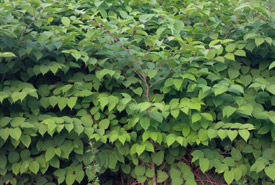
Japanese knotweed (Photo by Paula Noël/NCC staff)
At the Nature Conservancy of Canada's Cuzen Property just south of Chatsworth Ontario, I monitor for Japanese knotweed, goutweed, periwinkle and lily-of-the-valley. The Cuzen Property lies alongside an isolated side road, and over the years had become a favourite place for dumping garden waste. Fortunately municipalities now operate compost sites where most people take their garden waste. Hopefully this composting process is rendering the non-native species found in garden waste harmless.
To help stop the spread of invasives into natural areas such as the Cuzen Property, there needs to be a greater awareness of invasive plants and how to manage them. Unfortunately this issue is not on most peoples’ radars. Hopefully by sharing our tried and tested knowledge, such as my experiences on the Cuzen Property, we can help spread awareness of the issue.

